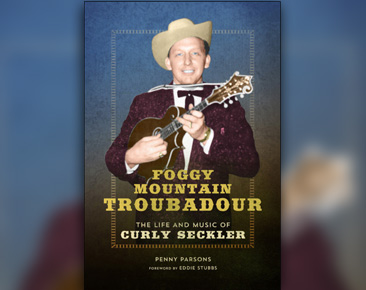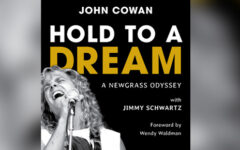
 Foggy Mountain Troubadour: The Life and Music of Curly Seckler a much anticipated biography by Penny Parsons is published today, Monday, May 23, 2016.
Foggy Mountain Troubadour: The Life and Music of Curly Seckler a much anticipated biography by Penny Parsons is published today, Monday, May 23, 2016.
It would be foolhardy to say that John Ray ‘Curly’ Seckler was a side-man; that is forgetting his 25 years as the leader of the Nashville Grass. However, he is probably best known for working with Lester Flatt, Earl Scruggs and the Foggy Mountain Boys.
Seckler first joined the Foggy Mountain Boys in March 1949. Initially he had met Flatt and Scruggs at a concert that they gave while based at WCYB in Bristol, Virginia in August 1948. Later that fall, Curly was also at WCYB as a member of Charlie Monroe’s Kentucky Partners, but at the end of the year he moved to Augusta, Georgia, to work with Hoke Jenkins, Jim and Jesse McReynolds and Wiley Morris in a band called the Smoky Mountaineers.
Thanks to the author and Angela L Burton of the University of Illinois Press we are able to share this extract from Foggy Mountain Troubadour that tells the story of Seckler joining the Foggy Mountain Boys……..
 Despite his first impression of Curly Seckler as a smart aleck, Lester Flatt had taken note when he heard Curly singing with Charlie Monroe at WCYB. When the Foggy Mountain Boys needed a new tenor singer in March 1949, Flatt tracked Curly down in Augusta and offered him the job. Given the opportunity to join an increasingly successful young band and earn $50 per week (good money in those days), Curly readily accepted, gave notice to Hoke Jenkins, and caught a bus to Bristol.
Despite his first impression of Curly Seckler as a smart aleck, Lester Flatt had taken note when he heard Curly singing with Charlie Monroe at WCYB. When the Foggy Mountain Boys needed a new tenor singer in March 1949, Flatt tracked Curly down in Augusta and offered him the job. Given the opportunity to join an increasingly successful young band and earn $50 per week (good money in those days), Curly readily accepted, gave notice to Hoke Jenkins, and caught a bus to Bristol.
The Foggy Mountain Boys had been in Bristol for almost a year at that point. The group had made a name for itself on Farm and Fun Time, but they had played out the area, and the local economy was suffering because of a coal miners’ strike. Mac Wiseman had stayed with the band until Christmas, but when the weather turned he was ready to move on. He went home briefly and then went to WSB in Atlanta to perform with Bill Carlisle. Soon afterward, Jim Shumate decided he had had enough of life on the road and returned to his furniture job in Hickory. His replacement was fiddler Art Wooten from Sparta, North Carolina. Art had worked previously with Bill Monroe and with the Stanley Brothers.
Although the Foggy Mountain Boys had begun as an equal partnership, Flatt and Scruggs had established themselves as the band’s leaders. As the original partners dropped out, beginning with Mac Wiseman and Jim Shumate, their replacements were hired as salaried employees. It is unclear why Flatt and Scruggs waited until March to find a replacement for Wiseman. Perhaps it was simply a matter of economics: they could not afford to support an additional musician during the lean winter months. Perhaps Curly Seckler was hired in response to Mercury Records’s desire for the band to record again. Transcriptions from a Flatt and Scruggs appearance on Farm and Fun Time after Wiseman’s departure indicate that Howard Watts was singing the tenor harmony. He had an extensive vocal range and was able to handle any part, but Watts could never match the power and edge of Curly’s natural tenor voice. Curly did remember that, nonetheless, on some of the first programs he played with the band, they performed the song “Summertime Is Past and Gone” with Watts singing the tenor part and Curly singing bass.
 When Curly joined the band, he discovered that Lester Flatt expected him to step into the role that Mac Wiseman had vacated, that of assistant Creating the Foggy Mountain Sound 73 master of ceremonies for the band’s stage shows. It was a baptism by fire, but he quickly adapted, and the experience would serve him well over the years. “I’d never did no commercial emcee work until I went to work with Lester,” Curly said. “And the first night I went to work with them, we got halfway through the show and he walked off. He said, ‘Seck, take over.’ And he did that from then on. He’d walk off the stage and I did half of the show. And that’s how I learned, was with Lester, because to me he was one of the greater emcees that’s ever been in bluegrass music.” Another thing Curly discovered was that the band members kept their instruments tuned a half step higher than standard tuning. As Curly understood it, this was because Earl felt that it made his banjo sound better.
When Curly joined the band, he discovered that Lester Flatt expected him to step into the role that Mac Wiseman had vacated, that of assistant Creating the Foggy Mountain Sound 73 master of ceremonies for the band’s stage shows. It was a baptism by fire, but he quickly adapted, and the experience would serve him well over the years. “I’d never did no commercial emcee work until I went to work with Lester,” Curly said. “And the first night I went to work with them, we got halfway through the show and he walked off. He said, ‘Seck, take over.’ And he did that from then on. He’d walk off the stage and I did half of the show. And that’s how I learned, was with Lester, because to me he was one of the greater emcees that’s ever been in bluegrass music.” Another thing Curly discovered was that the band members kept their instruments tuned a half step higher than standard tuning. As Curly understood it, this was because Earl felt that it made his banjo sound better.
Within days of Curly’s arrival in Bristol, the Foggy Mountain Boys pulled up stakes and moved to WROL in Knoxville. Curly did not own a car, so he rode along with Earl and Louise Scruggs in Earl’s 1941 Buick. Louise, who was pregnant at the time, would give birth to their first son, Gary, on May 18.
 From Foggy Mountain Troubadour: The Life and Music of Curly Seckler by Penny Parsons. Copyright 2016 by the Board of Trustees of the University of Illinois. Used with permission of the University of Illinois Press.
From Foggy Mountain Troubadour: The Life and Music of Curly Seckler by Penny Parsons. Copyright 2016 by the Board of Trustees of the University of Illinois. Used with permission of the University of Illinois Press.
The book is available from Curly’s website, the University of Illinois Press and all good bookshops.







